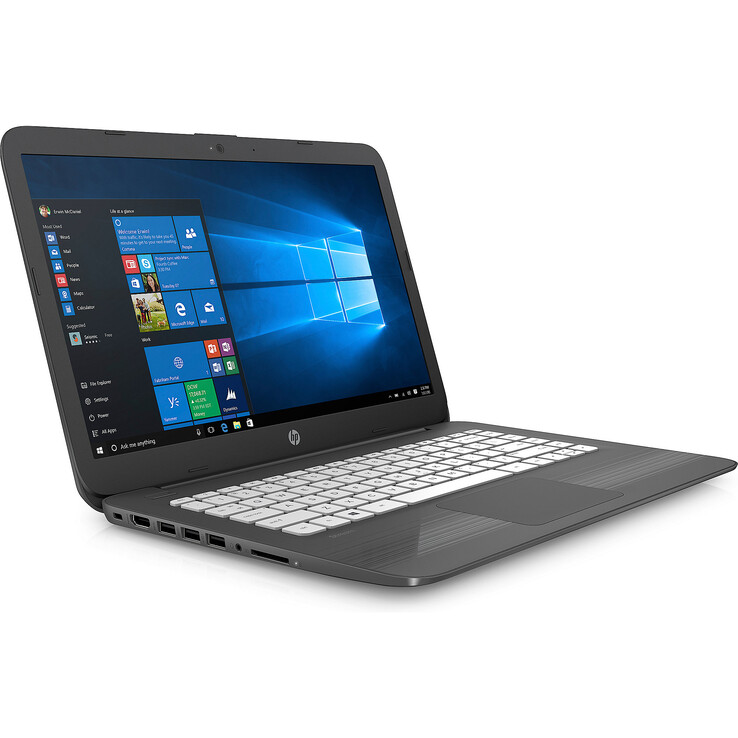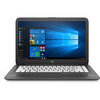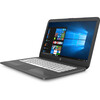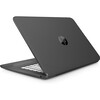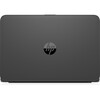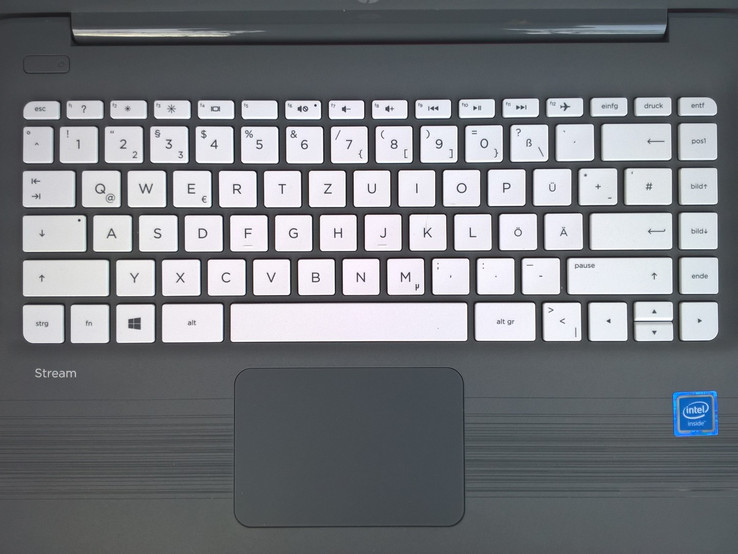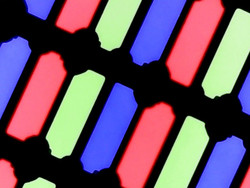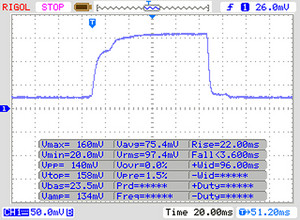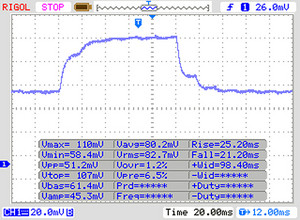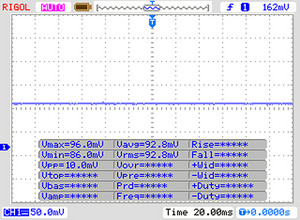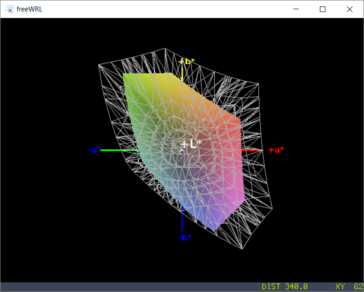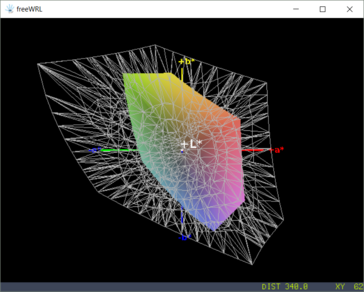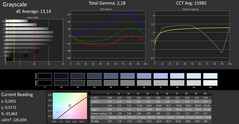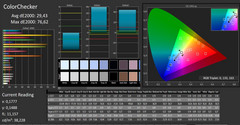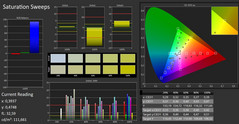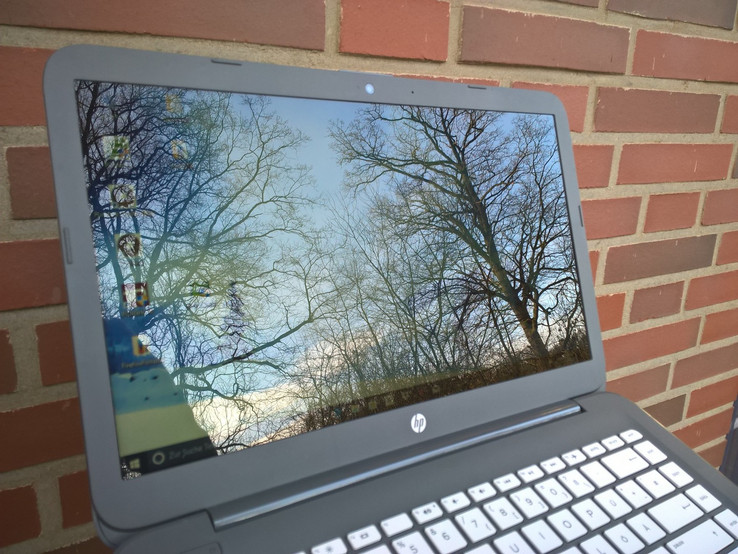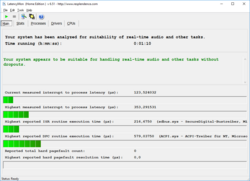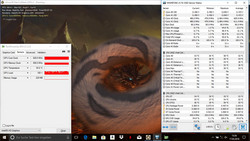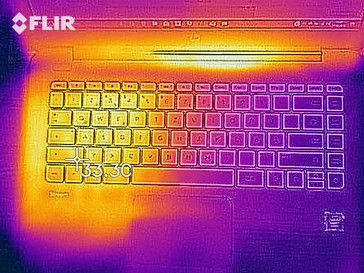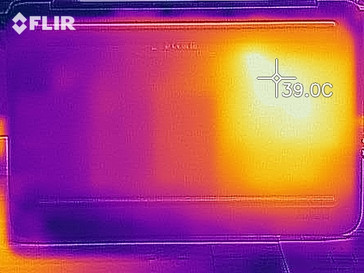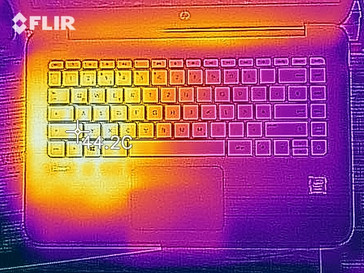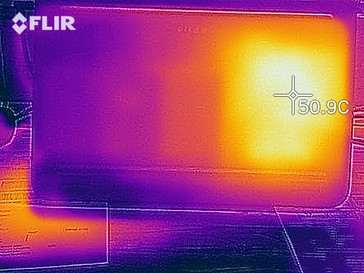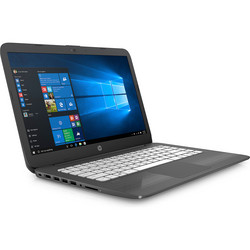HP Stream 14 (N3060, HD400) Laptop Review

The Stream series by HP has now been around for a view years, being incrementally updated over time. Buyers always got a simple notebook in a variety of shapes and sizes priced between 300 and 400 Euros (~$370 - $500). Back in 2014, the HP Stream 14-z050ng was praised by us, though a matte screen, a longer battery life, and a different price politic were on our wish list. As Chromebook competitors have gotten less numerous since then, the price of currently about 300 Euros (~$370) has become more of an argument.
Our test device is equipped with an Intel Celeron N3060 processor with an integrated HD Graphics 400 GPU. 4 GB of memory and 32 GB eMMC based storage are there to deal with the Windows 10 installation on the system. With this equipment, there are a few competitors in a similar price range, like the Acer Aspire 1 A114-31-C472, the IdeaPad 120s by Lenovo and the Chuwi LapBook 14.
Chassis and equipment - HP laptop made of plastic
Those interested in the HP Stream 14 can decide between four different color variants. Our test device is gray; other colors on offer are white, blue and purple. The chassis is made of soft plastic but appears of sturdy construction. HP does not enable easy access for maintenance or swapping the battery. The low weight, paired with the size of this 14-inch notebook, enable great mobility. The chassis gives off a sturdy impression, making the daily transport in a bag worry free.
HP has taken care of basic connection options. The majority of ports are concentrated on the left side of the device. On the right, only the charging port can be found. The built-in SD card reader provides decent transfer rates. Considering its nature as an office laptop, the results the SD card reader delivers are above average. The HP Stream 14 supports the fast ac WLAN standard and thus achieves decent WLAN speeds. The terrible HP 14 notwithstanding, most results are almost identical to the competition.
Connectivity
| SD Card Reader | |
| average JPG Copy Test (av. of 3 runs) | |
| HP Stream 14-ax002ng (Toshiba Exceria Pro SDXC 64 GB UHS-II) | |
| Acer Aspire 1 A114-31-C472 (Toshiba Exceria Pro SDXC 64 GB UHS-II) | |
| Lenovo Ideapad 120s-11IAP (Toshiba Exceria Pro M401) | |
| Average of class Office (22.4 - 198.5, n=28, last 2 years) | |
| Chuwi LapBook 14 inch 2017 | |
| HP 14-bp001ng (Toshiba Exceria Pro SDXC 64 GB UHS-II) | |
| maximum AS SSD Seq Read Test (1GB) | |
| Acer Aspire 1 A114-31-C472 (Toshiba Exceria Pro SDXC 64 GB UHS-II) | |
| Lenovo Ideapad 120s-11IAP (Toshiba Exceria Pro M401) | |
| HP Stream 14-ax002ng (Toshiba Exceria Pro SDXC 64 GB UHS-II) | |
| Average of class Office (25 - 249, n=26, last 2 years) | |
| Chuwi LapBook 14 inch 2017 | |
| HP 14-bp001ng (Toshiba Exceria Pro SDXC 64 GB UHS-II) | |
| Networking | |
| iperf3 transmit AX12 | |
| Lenovo Ideapad 120s-11IAP | |
| Chuwi LapBook 14 inch 2017 | |
| HP Stream 14-ax002ng | |
| Acer Aspire 1 A114-31-C472 | |
| HP 14-bp001ng | |
| iperf3 receive AX12 | |
| Chuwi LapBook 14 inch 2017 | |
| Lenovo Ideapad 120s-11IAP | |
| Acer Aspire 1 A114-31-C472 | |
| HP Stream 14-ax002ng | |
| HP 14-bp001ng | |
Input devices - solid laptop keyboard
The keyboard of the Stream 14 offers soft haptic feedback, with a light pressure point. Due to their texturized surface, keys are easy to find by touch and nice to press. Even longer writing is pleasant on the Stream 14. As a mouse replacement, our test device is equipped with a ClickPad. Movement of the cursor is being tracked reliably in all four corners. To perform a right click, one has to press down the pad in the lower right corner, anything slightly left from that point gets interpreted as a left click.
Display - Low-resolution screen
The Stream 14 is equipped with a glossy TN LED panel with a resolution of 1366x768 pixels. The average brightness is low, though that is to be expected in this price class. Distribution of brightness is rather inconsistent as well. From the top right, down to the bottom left, the brightness falls by a whole 50 cd/m².
Most competitors deliver better results in this class. However, HP did not use PWM to control the brightness; the device is thus suitable for users with more sensitive eyes.
| |||||||||||||||||||||||||
Brightness Distribution: 78 %
Center on Battery: 185 cd/m²
Contrast: ∞:1 (Black: 0 cd/m²)
ΔE ColorChecker Calman: 29.43 | ∀{0.5-29.43 Ø4.78}
ΔE Greyscale Calman: 13.14 | ∀{0.09-98 Ø5}
55% sRGB (Argyll 1.6.3 3D)
35% AdobeRGB 1998 (Argyll 1.6.3 3D)
38.06% AdobeRGB 1998 (Argyll 3D)
55.5% sRGB (Argyll 3D)
36.84% Display P3 (Argyll 3D)
Gamma: 2.18
CCT: 15985 K
| HP Stream 14-ax002ng AU Optronics AUO2D3C, , 1366x768, 14" | Acer Aspire 1 A114-31-C472 CMN N140BGA_EA3, , 1366x768, 14" | HP 14-bp001ng BOE0697, , 1366x768, 14" | Lenovo Ideapad 120s-11IAP AU Optronics AUO-B116XTN02.5 , , 1366x768, 11.6" | Chuwi LapBook 14 inch 2017 Name: BOE06A8, , 1920x1080, 14.1" | |
|---|---|---|---|---|---|
| Display | 12% | 10% | 6% | 15% | |
| Display P3 Coverage (%) | 36.84 | 41.31 12% | 40.43 10% | 39.03 6% | 42.53 15% |
| sRGB Coverage (%) | 55.5 | 61.7 11% | 60.8 10% | 58.7 6% | 63.6 15% |
| AdobeRGB 1998 Coverage (%) | 38.06 | 42.72 12% | 41.77 10% | 40.33 6% | 43.93 15% |
| Response Times | 25% | 26% | -25% | 6% | |
| Response Time Grey 50% / Grey 80% * (ms) | 46 ? | 40 ? 13% | 43 ? 7% | 72.8 ? -58% | 32.8 ? 29% |
| Response Time Black / White * (ms) | 25 ? | 16 ? 36% | 14 ? 44% | 22.8 ? 9% | 29.2 ? -17% |
| PWM Frequency (Hz) | 1000 ? | 200 ? | 200 ? | ||
| Screen | 22% | 21% | 23% | 36% | |
| Brightness middle (cd/m²) | 220 | 206 -6% | 189 -14% | 266.2 21% | 247.7 13% |
| Brightness (cd/m²) | 207 | 187 -10% | 190 -8% | 251 21% | 243 17% |
| Brightness Distribution (%) | 78 | 82 5% | 88 13% | 90 15% | 92 18% |
| Black Level * (cd/m²) | 0.34 | 0.53 | 0.67 | 0.32 | |
| Colorchecker dE 2000 * | 29.43 | 10.01 66% | 11.85 60% | 12.4 58% | 6.4 78% |
| Colorchecker dE 2000 max. * | 76.62 | 16.72 78% | 20.61 73% | 24.5 68% | 24.3 68% |
| Greyscale dE 2000 * | 13.14 | 11.11 15% | 13.6 -4% | 14.4 -10% | 4.5 66% |
| Gamma | 2.18 101% | 2.43 91% | 2.49 88% | 2.16 102% | 2.33 94% |
| CCT | 15985 41% | 12726 51% | 16588 39% | 19436 33% | 7318 89% |
| Color Space (Percent of AdobeRGB 1998) (%) | 35 | 39 11% | 49 40% | 37 6% | 39.8 14% |
| Color Space (Percent of sRGB) (%) | 55 | 62 13% | 61 11% | 59 7% | 62.9 14% |
| Contrast (:1) | 606 | 357 | 397 | 774 | |
| Total Average (Program / Settings) | 20% /
20% | 19% /
19% | 1% /
12% | 19% /
27% |
* ... smaller is better
Display Response Times
| ↔ Response Time Black to White | ||
|---|---|---|
| 25 ms ... rise ↗ and fall ↘ combined | ↗ 22 ms rise | |
| ↘ 3 ms fall | ||
| The screen shows relatively slow response rates in our tests and may be too slow for gamers. In comparison, all tested devices range from 0.1 (minimum) to 240 (maximum) ms. » 58 % of all devices are better. This means that the measured response time is worse than the average of all tested devices (20.2 ms). | ||
| ↔ Response Time 50% Grey to 80% Grey | ||
| 46 ms ... rise ↗ and fall ↘ combined | ↗ 25 ms rise | |
| ↘ 21 ms fall | ||
| The screen shows slow response rates in our tests and will be unsatisfactory for gamers. In comparison, all tested devices range from 0.165 (minimum) to 636 (maximum) ms. » 78 % of all devices are better. This means that the measured response time is worse than the average of all tested devices (31.6 ms). | ||
Screen Flickering / PWM (Pulse-Width Modulation)
| Screen flickering / PWM not detected | |||
In comparison: 53 % of all tested devices do not use PWM to dim the display. If PWM was detected, an average of 8108 (minimum: 5 - maximum: 343500) Hz was measured. | |||
Our test device delivers a very cool image and gives us the lowest results in terms of color representation in our comparison. It is however not very far behind any of them and the screen should be enough for video streams, writing and surfing the Internet. The glossy plastic surface of the display leads to a clear image, the Stream 14 is not suitable for outside use because of it though. The reflections make the device basically unusable outside as content becomes unreadable.
Performance - Simple streaming device by HP
The Stream 14 by HP is aimed at newcomers. The only equipment level on offer thus gives one just enough performance for basic notebook tasks, like writing, surfing online and viewing basic media content. Users will have to make do with the Intel Celeron N3060, the integrated HD Graphics 400, the 4 GB of memory and the 32 GB of storage space. Expanding the storage is possible via the SD card reader. Additionally, one year of free 1 TB OneDrive storage is included upon purchasing the Stream 14.
Processor
The Intel Celeron N3060 is a processor mainly designed for use in passively cooled laptops. With a base clock of 1.6 GHz and a turbo boost frequency of up to 2.5 GHz, it is mainly suited for less demanding tasks.
The N3060 gets results behind other devices equipped with the same processor. It should be noted that competitors like the Aspire 1 get a 30 percent higher Cinebench R15 score while being more affordable.
| Cinebench R15 | |
| CPU Single 64Bit | |
| Average of class Office (99.5 - 312, n=80, last 2 years) | |
| Acer Aspire 1 A114-31-C472 | |
| Lenovo Ideapad 120s-11IAP | |
| HP 14-bp001ng | |
| Average Intel Celeron N3060 (36 - 39, n=4) | |
| Chuwi LapBook 14 inch 2017 | |
| HP Stream 14-ax002ng | |
| CPU Multi 64Bit | |
| Average of class Office (246 - 3380, n=80, last 2 years) | |
| Acer Aspire 1 A114-31-C472 | |
| HP 14-bp001ng | |
| Chuwi LapBook 14 inch 2017 | |
| Lenovo Ideapad 120s-11IAP | |
| HP Stream 14-ax002ng | |
| Average Intel Celeron N3060 (68 - 74, n=4) | |
System Performance
System performance is comparable to other notebooks equipped with the Intel Celeron N3060. In PCMark8, the Stream 14 reaches only the second last place. Expect loading times when opening applications.
The results of other Intel Celeron N3060 equipped laptops can be read on our Benchmark page.
| PCMark 8 - Home Score Accelerated v2 | |
| Average of class Office (n=1last 2 years) | |
| Acer Aspire 1 A114-31-C472 | |
| Lenovo Ideapad 120s-11IAP | |
| HP 14-bp001ng | |
| HP Stream 14-ax002ng | |
| Average Intel Celeron N3060, Intel HD Graphics 400 (Braswell) (1661 - 1771, n=4) | |
| Chuwi LapBook 14 inch 2017 | |
| PCMark 8 Home Score Accelerated v2 | 1760 points | |
Help | ||
Mass Storage
HP equipped the Stream 14 with 32 GB of eMMC storage. Only 8 GB are actually usable. However, one year of free OneDrive storage (1 TB) is included with the Stream 14. Adding to that, the SanDisk DF4032 built into the Stream 14 is rather slow when comparing it to alternatives.
How this notebook's storage stacks up against others can be read here.
| HP Stream 14-ax002ng SanDisk DF4032 | Acer Aspire 1 A114-31-C472 Hynix HBG4a2 32 GB eMMC | HP 14-bp001ng Toshiba MQ01ABF050 | Lenovo Ideapad 120s-11IAP 64 GB eMMC Flash | Chuwi LapBook 14 inch 2017 SanDisk DF4128 | Average SanDisk DF4032 | Average of class Office | |
|---|---|---|---|---|---|---|---|
| CrystalDiskMark 5.2 / 6 | 159% | -39% | 34% | 59% | 25% | 3330% | |
| Write 4K (MB/s) | 7.611 | 31.55 315% | 0.955 -87% | 12.19 60% | 11.87 56% | 10.9 ? 43% | 155.6 ? 1944% |
| Read 4K (MB/s) | 13.21 | 10.58 -20% | 0.367 -97% | 6.61 -50% | 11.45 -13% | 10.9 ? -17% | 73.4 ? 456% |
| Write Seq (MB/s) | 65.8 | 148.5 126% | 92.5 41% | 108.2 64% | 106.1 61% | 85.1 ? 29% | 2675 ? 3965% |
| Read Seq (MB/s) | 120.6 | 272 126% | 101.5 -16% | 167.1 39% | 293.6 143% | 177.6 ? 47% | 3233 ? 2581% |
| Write 4K Q32T1 (MB/s) | 7.547 | 49.07 550% | 0.951 -87% | 15.38 104% | 15.22 102% | 11.2 ? 48% | 420 ? 5465% |
| Read 4K Q32T1 (MB/s) | 35.25 | 31.92 -9% | 0.734 -98% | 31.28 -11% | 33.91 -4% | 34.6 ? -2% | 519 ? 1372% |
| Write Seq Q32T1 (MB/s) | 61.5 | 139 126% | 93.1 51% | 96.2 56% | 110.3 79% | 82.8 ? 35% | 3954 ? 6329% |
| Read Seq Q32T1 (MB/s) | 122 | 196.3 61% | 102 -16% | 134.1 10% | 183 50% | 139.9 ? 15% | 5641 ? 4524% |
GPU
Graphics are handled by an Intel HD Graphics 400 GPU. Only applications not stressing the system's graphics are suited to such a low-end GPU. 4k/H.265 videos are fluid, however.
Our comparison of the Intel HD Graphics 400 with other GPUs may be found here.
| 3DMark 11 - 1280x720 Performance GPU | |
| Average of class Office (1468 - 16418, n=73, last 2 years) | |
| Lenovo Ideapad 120s-11IAP | |
| HP 14-bp001ng | |
| Acer Aspire 1 A114-31-C472 | |
| Chuwi LapBook 14 inch 2017 | |
| HP Stream 14-ax002ng | |
| Average Intel HD Graphics 400 (Braswell) (247 - 418, n=11) | |
| 3DMark 11 Performance | 421 points | |
Help | ||
Gaming Performance
It should come as no surprise, but the Intel HD Graphics 400 is not suited to gaming. Older or less complex titles may work, however. The five-year-old Bioshock Infinite was unplayable, even on the lowest settings.
| low | med. | high | ultra | |
|---|---|---|---|---|
| BioShock Infinite (2013) | 16.53 | 9.11 |
Emissions and energy - Frugal laptop with long battery life
Noise emissions
As the Stream 14 is cooled passively, there is no fan that could cause noise. Likewise, there is no coil whine or other unwanted sound being emitted from our test device.
Temperature
The surface of our test device does not warm while idling, even under load temperatures do not rise dramatically. The processor was however not able to hold its turbo frequency for long during our testing. After that, the frequency fell well below the base clock and was not able to stabilize during the remainder of our two-hour test.
During day-to-day use though, this should be of little concern as this test simulated an extreme situation.
(±) The maximum temperature on the upper side is 40.4 °C / 105 F, compared to the average of 34.3 °C / 94 F, ranging from 21.2 to 62.5 °C for the class Office.
(±) The bottom heats up to a maximum of 42.7 °C / 109 F, compared to the average of 36.8 °C / 98 F
(+) In idle usage, the average temperature for the upper side is 26.6 °C / 80 F, compared to the device average of 29.5 °C / 85 F.
(+) The palmrests and touchpad are cooler than skin temperature with a maximum of 30.6 °C / 87.1 F and are therefore cool to the touch.
(-) The average temperature of the palmrest area of similar devices was 27.6 °C / 81.7 F (-3 °C / -5.4 F).
Speakers
The Stream 14’s speakers sound very balanced. Bass drops off a little early, though is not as weak as on the IdeaPad 120s. The speakers did not appear tinny; customers should however not expect perfect audio from this device.
HP Stream 14-ax002ng audio analysis
(±) | speaker loudness is average but good (76 dB)
Bass 100 - 315 Hz
(-) | nearly no bass - on average 26% lower than median
(±) | linearity of bass is average (11.8% delta to prev. frequency)
Mids 400 - 2000 Hz
(+) | balanced mids - only 2.8% away from median
(±) | linearity of mids is average (7.2% delta to prev. frequency)
Highs 2 - 16 kHz
(±) | higher highs - on average 6.9% higher than median
(+) | highs are linear (6.6% delta to prev. frequency)
Overall 100 - 16.000 Hz
(±) | linearity of overall sound is average (21.9% difference to median)
Compared to same class
» 55% of all tested devices in this class were better, 8% similar, 36% worse
» The best had a delta of 7%, average was 21%, worst was 53%
Compared to all devices tested
» 62% of all tested devices were better, 7% similar, 31% worse
» The best had a delta of 4%, average was 24%, worst was 134%
Apple MacBook 12 (Early 2016) 1.1 GHz audio analysis
(+) | speakers can play relatively loud (83.6 dB)
Bass 100 - 315 Hz
(±) | reduced bass - on average 11.3% lower than median
(±) | linearity of bass is average (14.2% delta to prev. frequency)
Mids 400 - 2000 Hz
(+) | balanced mids - only 2.4% away from median
(+) | mids are linear (5.5% delta to prev. frequency)
Highs 2 - 16 kHz
(+) | balanced highs - only 2% away from median
(+) | highs are linear (4.5% delta to prev. frequency)
Overall 100 - 16.000 Hz
(+) | overall sound is linear (10.2% difference to median)
Compared to same class
» 7% of all tested devices in this class were better, 2% similar, 91% worse
» The best had a delta of 5%, average was 18%, worst was 53%
Compared to all devices tested
» 4% of all tested devices were better, 1% similar, 94% worse
» The best had a delta of 4%, average was 24%, worst was 134%
Frequency diagram in comparison (checkboxes can be checked and unchecked!)
Energy consumption
The Stream 14 is a very energy efficient device. As it only requires 12 W of power even under load, the included 45 W power supply should be large enough.
| Off / Standby | |
| Idle | |
| Load |
|
Key:
min: | |
Battery life
The battery life of the Stream 14 is the best in our comparison. In our real-world WLAN test, it gets a result of almost 10 hours of simulated web browsing. We thus almost reached HP’s claimed 10.5 hours.
| Battery Runtime - WiFi Websurfing | |
| Average of class Office (3.83 - 31.5, n=79, last 2 years) | |
| HP Stream 14-ax002ng | |
| Lenovo Ideapad 120s-11IAP | |
| HP 14-bp001ng | |
| Chuwi LapBook 14 inch 2017 | |
| Acer Aspire 1 A114-31-C472 | |
Pros
Cons
Verdict - HP, low on storage
Buyers of the HP Stream 14 should be aware of the fact that they purchase a simple notebook with little to no internal storage. To access the cloud storage, a WLAN connection is required, as the device on its own does not offer Internet connectivity. Aside from that, the Stream 14 is a solid device, suitable for simple office tasks and playback of streaming content.
The Stream 14 by HP is a simple, but solid notebook. If one gets accustomed to the low storage, they get a laptop, equipped to handle office tasks and streaming.
The system performance of our test device fits what we know from other devices equipped with the Intel Celeron N3060. The main gripe we have is the low storage space, which made installing benchmarking software quite a hassle. Considering future Windows updates, we can picture the storage space running out sooner, rather than later.
HP Stream 14-ax002ng
- 03/20/2018 v6 (old)
Mike Wobker




